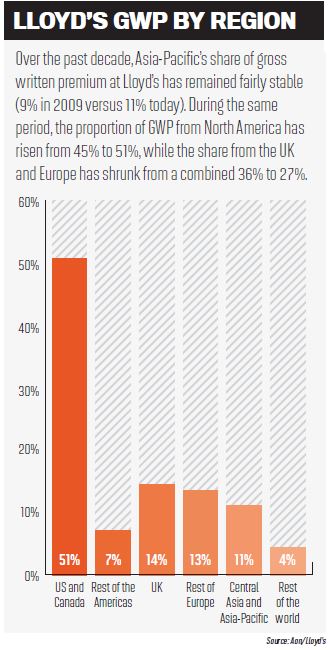

In the midst of the many challenges that have plagued the London market, will a new modernisation strategy at Lloyd’s help to revitalise the global centre of insurance?
Long regarded as the centre of the world’s insurance market, London has been hit with its fair share of challenges in recent years. From customers turning to local and emerging markets for insurance and reinsurance solutions, to a looming talent gap that has hit insurance companies in many parts of the world, experts have been warning about the threats to London’s position as the go-to global market for specialty commercial insurance for several years.
“What people are concerned about is the fact that firstly, the share of the global insurance market that comes to London is declining,” says Jamie Althorp, managing director for Accenture Financial Services and leader of the company’s London markets and specialty practice. “The global insurance market is growing quicker than the London insurance market, and that would therefore suggest that there’s a high proportion of insurance that is being written outside of London.”
Low interest rates have also become the new normal, which is impacting insurance business in many regions, but certainly in London, where insurers can’t make the same returns on investments as they once did. Yet in spite of these and other challenges, the market continues to have a lot going for it.
“London is still a very vibrant insurance market, and that will remain for the time to come because it’s got that reputation, and ultimately, insurance is about trust,” Althorp says. “You have to trust that the organisation you’re insuring with is going to be able to pay in the event of a claim, and London and Lloyd’s provide that trust. Most importantly, you’ve got a critical mass of talent here – brokers, underwriters, lawyers and various experts that you need to make a market work. The concern is that those things will erode over time.”
The focus on cutting costs hasn’t made brokers’ jobs any easier. There’s been a lot of emphasis on trying to reduce costs within insurance organisations as they strive for efficiency, and that’s been the case for brokers and underwriters as well.
The pace of mergers and acquisitions is likewise putting pressure on everyone in the global insurance value chain. According to Clyde & Co’s Insurance Growth Report, the first half of 2019 saw 222 completed M&A deals worldwide, up from 196 in the second half of 2018. That represents a 13% increase in the volume of transactions – the highest since the first half of 2015.

The proposed ideas, which are now being rolled out, include a platform for complex risk that enables digital placement, flexible capital that can access diverse risks on the platform, the launch of the Lloyd’s Risk Exchange for the placement of less complex risks, the Syndicate-in-a-Box solution, next-generation claims services, and an ecosystem of services that lend market participants a hand in developing new business and providing high-quality services to their clientele.
“Implicit in [this strategy] is that they’re being very collaborative in a way that previous iterations of modernisation work at Lloyd’s hadn’t been,” says Christopher Croft, chief executive of the London & International Insurance Brokers’ Association [LIIBA]. “There’s broker representation on the global advisory board, and at the lower level, we have a lot of our practitioners plugged into the relevant workstreams who are providing feedback, but are also crucially seeing things change as a result of that feedback on occasion – so it’s not just a PR exercise.”
And while implementing the sweeping changes won’t be easy, Croft believes the market is on the right track to patching its profitability gaps, along with addressing other issues.
“Actually doing it will be a challenge,” he says. “It’s a market without a great reputation for implementing change programs, so regardless of what you might think about the individual workstreams, there’s a big job to do. The sooner they can start demonstrating some delivery momentum, the better, because that’s where those who wish to be sceptical will concentrate their scepticism.”
